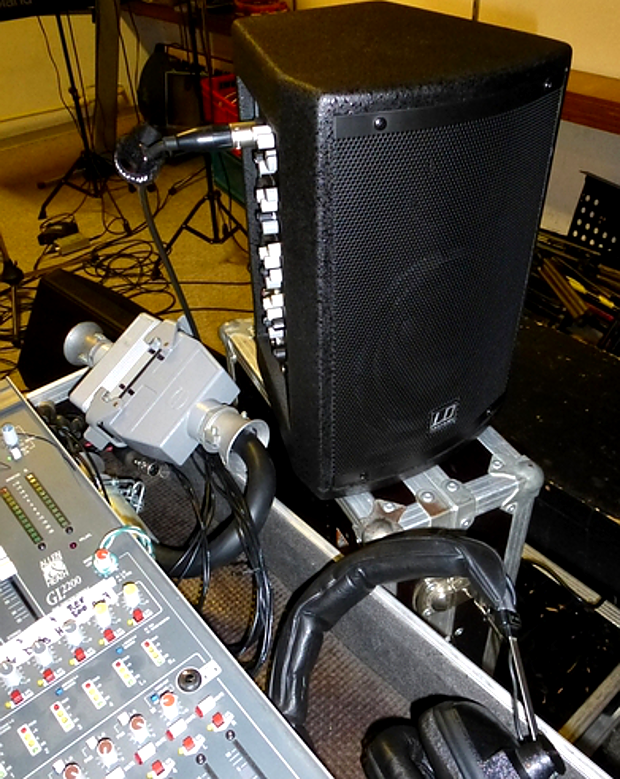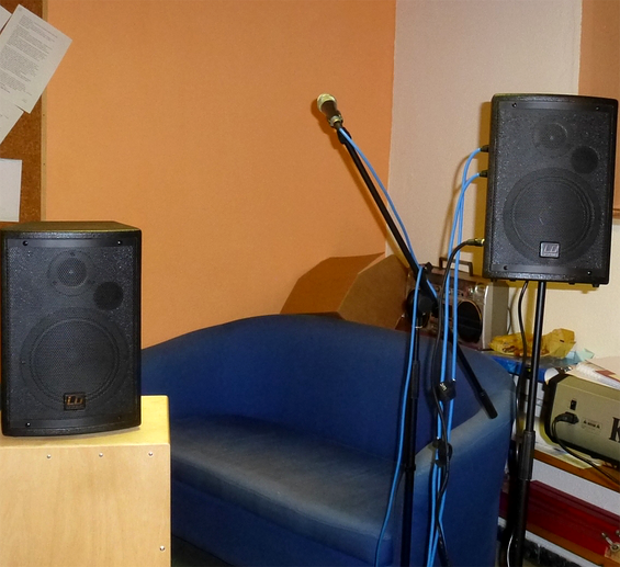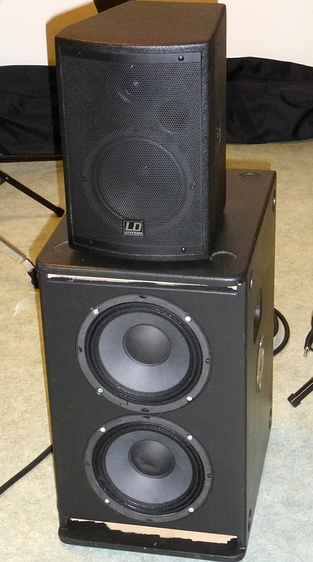LD Systems MIX6AG2 and MIX6G2 – Product Review (1/2) by Musiker Board
Two users of the platform Musiker-Board.de tested a MIX6AG2 active box donated by LD Systems, as well as its passive counterpart MIX6G2. This first test was carried out by user “mHs”, and particularly looks at the practicality of the two PA systems in different scenarios.

In addition to standard PA requirements, namely to provide good sound solutions for medium to large audiences, the need for a small, compact sound system also often arises.
This is how I got the opportunity to test the speaker combination LD MIX6AG2 LD MIX6G2 from the Stinger MIX G2 series from LD Systems.

The active LD Systems MIX6AG2 speaker with built-in mini mixer and 2 x 70 W on 4 ohms amplifier is a 2-way speaker. It is equipped with a 6.5″ woofer and a 1″ tweeter. The housing is made from MDF, which does not necessarily stand for full road usability, but is still quite acceptable for a speaker of this size and is covered with rugged-looking textured paint. You’ll be looking in vain for handles on the cabinet, which I believe is quite alright, given its size and weight.
A flange for mounting a stand is built at the bottom and on one side. LD Systems offers a suitable tripod in its accessories assortment. Due to the diameter, mounting on a microphone stand would be the obvious choice. I’ve tried this with a tripod from K&M but was however not very convinced by the result. It looked a bit wobbly. 4 small, but completely adequate rubber feet are also attached to the bottom of the speaker.
A heat sink and an IEC socket together with power switch and fuse are located on the back panel.

The mixer section is set into the side of the cabinet.

3 channels with combo-jacks (XLR and jack) are available. For each channel, there is dial for High, Low, Level and Effect Proportion. For these 3 channels, phantom power can be fed by means of a sliding switch. A 4th channel has input jacks for 2 x RCA, 1 x stereo mini-jack. The two signals are summed internally and processed as a Mono signal. This channel has the same control options as the first 3 channels.
You can route the signal of the 3 above mentioned input channels to the built-in digital effects device using the effects controller. There are 16 presets for different types of reverb, delay, and combinations of reverb and delay or chorus in the effects device. The output of the effects unit can be adjusted via a dedicated controller. In addition, a switch is available to mute the effect.
As “Master section”, controllers for Low (80 Hz) Mid (2.5 kHz) High (12 kHz) and Master level are available. For visual monitoring, there is a level meter with 4 LEDs and a power LED.
The signal behind the master controller is redirected to the two internal power amplifiers. Through one of the two power amplifiers, it then passes to the tweeter and woofer. The other amplifier signal is routed to the Main Power Out jack socket. The passive speaker LD MIX6G2 can be connected there. In addition, there is a monitor output with its own controller for the overall volume. The sum signal is always present at this jack.
The edges of the processed plates are visible on the speaker cabinets.
Furthermore, the solid-looking grille is not evenly inserted. Both points probably fall into the category of “optical defect”, but are only visible on closer inspection. Functionally, they would have no impact.
The second speaker, the LD MIX6G2, is the passive counterpart to the active version and is connected with a speaker cable to the second channel of the power amplifier. It has the same dimensions and features as the active speaker, minus of course the amplifier and mixer.
Since the speaker cable requires jack connectors to connect the two speakers with each other, I had to solder an appropriate cable. I haven’t had this type of cable in stock “for ages”.
The speakers in practice
Unpacking
After unpacking the speakers and a first visual inspection, I was able to get the system up and running immediately. Connected to my laptop using a mini jack to 2 x RCA cable, the speaker quite clearly revealed the limitations of the sound card in my computer. The very low noise of the speaker is quite a positive aspect. But nevertheless, I quickly switched from the computer to a CD player. So I arrived at my first real impression:
Clear, honest, and overall very pleasant and not too intrusive.
As expected due to the size of the cabinet and subwoofer, the speakers provide no real deep bass, but this should already become apparent from looking at the frequency response. It is specified at 80-20,000 Hz. I was rather surprised by the volume attained by the system. I had not expected such a high level.
Acoustic guitar
Next, I connected an acoustic guitar, an older Yamaha CPX, to the active speaker. Since the guitar has an active pickup, I could use one of the 3 input channels and was not limited to the first channel on the existing high Z circuit. In the absence of an instrument with passive pickup, I could unfortunately not test this circuit.
On the speaker, the guitar sounds direct and honest, the frequency response of the speaker is good enough for the application. The Piezo-typical colouring of the guitar sound and the usual overstress of the pluck and stop noise was of course also present. In addition to providing the sound for the audience, I could imagine this speaker as a guitar monitor for the musician on stage, as well.
Monitor on the mixer console in the rehearsal room
In a room not optimised for acoustics, a band was rehearsing with multiple wedges. In this environment, I used a few Yamaha S12 (older compact speakers, slightly better than e.g. JBL Control1) for listening on the mixer console. I replaced this setup with the active LD MIX6AG2 during a rehearsal. My initial impression of the speaker was again confirmed. The good resolution of the audio signal was helpful under less than optimal conditions in the rehearsal room, while still working on the sound of the band. However, we should at least exercise some caution with the master controller here. Fully turned on, the speaker provides quite an impressive volume level, which is certainly not good for the ears in the long run, if the speaker, as in this specific application, is just over half a metre away from your ears.

Singer Songwriter Duo
For another test, I wanted to use both speakers with a singer/songwriter duo. Unfortunately, no one was scheduled during the test period, so we had to find an alternative using a larger, quite decent-sounding rehearsal room. Both ladies used LD D1011 capacitor microphones for singing, which I rather like using for female voices. In addition, an acoustic guitar from Martin with active pickup was also used. On the console of the active speaker, I enabled the phantom power for this and soon the system felt quite at ease with the incoming signals.
Here also, the internal effects unit was used to round off the voices with some reverb. The effects are quite suitable for such an application, but of course in this speaker, you don’t have a fully fledged effects processor with various editing options. In this scenario, I could well imagine the system in smaller music venues/pubs with up to 50/60 visitors. Da sound was pleasant and quite present.

2-way active
In a final test, I wanted to deliberately push the passive box to its limit. – To the people of LD Systems: Don’t worry, I was careful and did not cause any damage – as the top part in a 2-way active application, I used the passive LD MIX6G2 along with my homemade double 8″ subwoofer. Using a BEHRINGER DCX with 24 dB slew rate at 130 Hz, I operated both the top and bass on an amplifier which can reach 2 x 500 W on 4 ohms. In this combination, I listened to various titles from CDs that I know very well. Relieved of the low frequencies, the LD MIX6G2 sounded significantly relaxed.
At a higher level, the speaker tends to produce a discrete “nasal twang” that I could easily correct by lowering by x dB to y (sorry, I must submit the values later, as my signal processor is currently unavailable).

In this configuration, the above mentioned music venue/pub could be larger still and accommodate 100 people or more… Some Cajon support or something similar would also benefit the singing duo with acoustic guitar.
Conclusion
Overall, I rather liked the two LD MIX6AG2 LD MIX6G2 speakers. Of course, we must take into account in the application that this is not a large active speaker, and that it only contains a 6.5″ woofer. But if you use the speakers for their intended purpose, then you can deliver convincing results. Regarding my volume assessments, it should be noted that I quite like it loud, but then I’m also conscious of my ears, so I’ don’t overdo it.
Concerning my personal needs, I could imagine purchasing 2 LD MIX6G2 to assemble the “small” system described above with a small subwoofer. Another application for the speaker could be as a delayline, if I needed more range with a band in a church for example, without having to play from the front at high volume.
Finally, I would like to thank LD Systems for these test speakers and Martin Hofmann for the mediation and organisation.
… and now I wish my colleague @chris_kah a lot of fun with these speakers. He will test them further after me.
I look forward to your results.
Source: musiker-board.de 25.09.2014
_________________________________________
Also, we at LD Systems would like to thank “mHs” for this very successful review and wish him a lot of fun with our products!
For more information on the tested products MIX6AG2 and MIX6G2, as well as on the remaining Stinger G2 series, please visit:
http://www.ld-systems.com/en/series/stinger-g2-series/
Leave a Comment
You must be logged in to post a comment.











